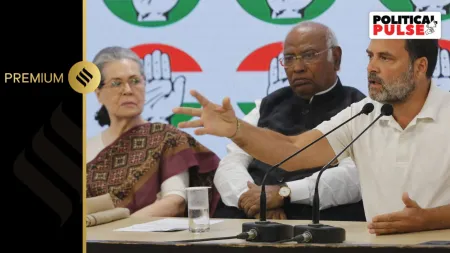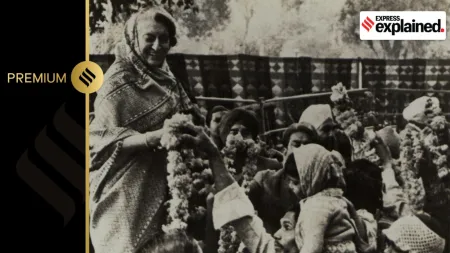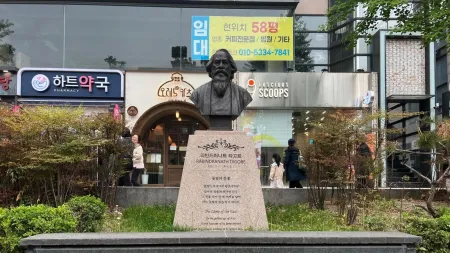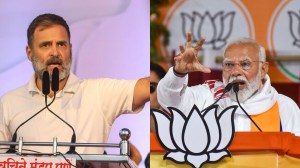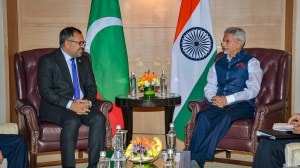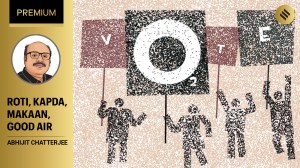- India
- International
India, that is Bharat: A short history of the nation’s names, from the Rig Veda to the Constitution of India
There is speculation of an official change in the name of the country from India to Bharat, even though Article 1 of the Constitution uses the two names interchangeably: “India, that is Bharat, shall be a Union of States.”
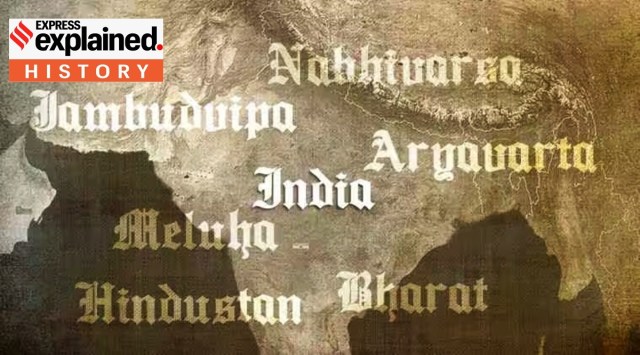 The roots of “Bharat”, “Bharata”, or “Bharatvarsha” are traced back to Puranic literature, and to the epic Mahabharata. The Puranas describe Bharata as the land between the “sea in the south and the abode of snow in the north”. (Photo via Wikimedia Commons)
The roots of “Bharat”, “Bharata”, or “Bharatvarsha” are traced back to Puranic literature, and to the epic Mahabharata. The Puranas describe Bharata as the land between the “sea in the south and the abode of snow in the north”. (Photo via Wikimedia Commons) Opposition politicians have been posting images of an official invitation to a G20 dinner hosted by “The President of Bharat” instead of the usual “President of India”.
There is speculation of an official change in the name of the country from India to Bharat, even though Article 1 of the Constitution uses the two names interchangeably: “India, that is Bharat, shall be a Union of States.” Also, several names such as Reserve Bank of India and the Indian Railways already have Hindi variants with “Bharatiya” in them.
In June 2020, the Supreme Court had dismissed a PIL seeking to remove “India” from the Constitution and retain only Bharat in order to “ensure the citizens of this country…get over the colonial past” saying: “India is already called Bharat in the Constitution itself.”
So where does the name ‘Bharat’ come from?
The roots of “Bharat”, “Bharata”, or “Bharatvarsha” are traced back to Puranic literature, and to the epic Mahabharata. The Puranas describe Bharata as the land between the “sea in the south and the abode of snow in the north”.
Social scientist Catherine Clémentin-Ojha explained Bharata in the sense of a religious and socio-cultural entity, rather than a political or geographical one. ‘Bharata’ refers to the “supraregional and subcontinental territory where the Brahmanical system of society prevails”, Clémentin-Ojha wrote in her 2014 article, ‘India, that is Bharat…’: One Country, Two Names (South Asia Multidisciplinary Academic Journal).

Bharata is also the name of the ancient king of legend who was the ancestor of the Rig Vedic tribe of the Bharatas, and by extension, the progenitor of all peoples of the subcontinent.
Writing in January 1927, Jawaharlal Nehru alluded to the “fundamental unity of India” that has endured from “the remote past”: “a unity of a common faith and culture. India was Bharata, the holy land of the Hindus, and it is not without significance that the great places of Hindu pilgrimage are situated in the four corners of India — the extreme South overlooking Ceylon, the extreme West washed by the Arabian Sea, the East facing the Bay of Bengal and the North in the Himalayas.” (Selected Works Vol. 2)
And what about ‘India’ and ‘Hindustan’?
The name Hindustan is thought to have derived from ‘Hindu’, the Persian cognate form of the Sanskrit ‘Sindhu’ (Indus), which came into currency with the Achaemenid Persian conquest of the Indus valley (northwestern parts of the subcontinent) that begin in the 6th century BC (which was the time of The Buddha in the Gangetic basin).
The Achaemenids used the term to identify the lower Indus basin, and from around the first century of the Christian era, the suffix “stan” came to be used with the name to create “Hindustan”.
The Greeks, who had acquired knowledge of ‘Hind’ from the Achaemenids, transliterated the name as ‘Indus’. By the time the Macedonian king Alexander invaded India in the 3rd century BC, ‘India’ had come to be identified with the region beyond the Indus.
By the time of the early Mughals (16th century), the name ‘Hindustan’ was used to describe the entire Indo-Gangetic plain. Historian Ian J Barrow in his article, ‘From Hindustan to India: Naming Change in Changing Names’ (Journal of South Asian Studies, 2003) wrote that “in the mid-to-late eighteenth century, Hindustan often referred to the territories of the Mughal emperor, which comprised much of South Asia”.
From the late 18th century onwards, British maps increasingly began to use the name ‘India’, and ‘Hindustan’ started to lose its association with all of South Asia. “Part of the appeal of the term India may have been its Graeco-Roman associations, its long history of use in Europe, and its adoption by scientific and bureaucratic organisations such as the Survey of India,” Barrow wrote.
“The adoption of India suggests how colonial nomenclature signalled changes in perspectives and helped to usher in an understanding of the subcontinent as a single, bounded and British political territory,” he added.
How did ‘Bharat’ and ‘India’ come into the Constitution?
In his monumental ‘Discovery of India’, Nehru referred to “India”, “Bharata” and “Hindustan”: “Often, as I wandered from meeting to meeting, I spoke to my audiences of this India of ours, of Hindustan and of Bharata, the old Sanskrit name derived from the mythical founders of the race.”
But when the question of naming India in the Constitution arose, ‘Hindustan’ was dropped, and both ‘Bharat’ and ‘India’ were retained.
During the Constituent Assembly debates the “Name and territory of the Union” was taken up for discussion on September 17, 1949. Right from the time the first article was read out as “India, that is Bharat, shall be a Union of States”, a division arose among the members. There were quite a few members who were against the use of the name ‘India’, which they saw as being a reminder of the colonial past.
Hari Vishnu Kamath suggested that the first article should read, “Bharat, or in the English language, India, shall be and such”. Seth Govind Das, representing the Central Provinces and Berar, proposed: “Bharat known as India also in foreign countries”.
Hargovind Pant, who represented the hill districts of the United Provinces, made it clear that the people of Northern India “wanted Bharatvarsha and nothing else”.
Pant argued: “So far as the word ‘India’ is concerned, the Members seem to have, and really I fail to understand why, some attachment for it. We must know that this name was given to our country by foreigners who, having heard of the riches of this land, were tempted towards it and had robbed us of our freedom in order to acquire the wealth of our country. If we, even then, cling to the word ‘India’, it would only show that we are not ashamed of having this insulting word which has been imposed on us by alien rulers.”
None of the suggestions were accepted by the committee. However, as Clémentin-Ojha pointed out in her article, they “illustrated contrasting visions of the budding nation’.
More Explained
EXPRESS OPINION
May 10: Latest News
- 01
- 02
- 03
- 04
- 05


